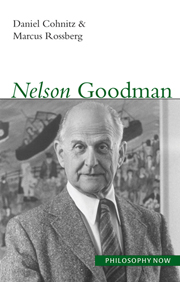Book contents
- Frontmatter
- Contents
- Acknowledgements
- Abbreviations
- 1 The worldmaker's universe
- 2 If this were an emerald it would be grue: problems and riddles of induction
- 3 The big picture
- 4 Particulars and parts
- 5 From Vienna Station to Boston Terminus
- 6 Follow the sign
- 7 Diagnosing art
- 8 Starmaking
- 9 Never mind mind, essence is not essential, and matter does not matter
- List of symbols
- Glossary of technical terms
- Further reading
- Notes
- Bibliography
- Index
3 - The big picture
- Frontmatter
- Contents
- Acknowledgements
- Abbreviations
- 1 The worldmaker's universe
- 2 If this were an emerald it would be grue: problems and riddles of induction
- 3 The big picture
- 4 Particulars and parts
- 5 From Vienna Station to Boston Terminus
- 6 Follow the sign
- 7 Diagnosing art
- 8 Starmaking
- 9 Never mind mind, essence is not essential, and matter does not matter
- List of symbols
- Glossary of technical terms
- Further reading
- Notes
- Bibliography
- Index
Summary
In this chapter we sketch how Goodman conceives of the purpose, aim and method of philosophy. We also indicate the way in which his thoughts on seemingly unrelated matters, such as art and induction, are connected to form a coherent whole. Few philosophers of the twentieth century have been as influential as Goodman, particularly across such diverse fields as the philosophy of art and the philosophy of science. What we hope to show is that this is due not only to an idiosyncratic coincidence of interests, but also to Goodman's account of philosophy.
What gives unity to Goodman's thought is his conception of philosophy as an activity directed at understanding and elucidation. For Goodman, such elucidation is achieved by way of definitions. One of the most remarkable aspects of Goodman's theory of definitions is that, in contrast to the ordinary-language tradition, a definition does not need to be synonymous with (i.e. identical in meaning to) the expression defined. As we shall explain, this is partly due to Goodman's conviction that no two distinct expressions of a language are identical in meaning. This provocative thesis is central to Goodman's thought.
What is philosophy good for?
Before turning to the questions of what – according to Goodman – philosophy is about and how it gets done, it might be instructive to see how Goodman conceived of its purpose and use. These days, philosophy is increasingly challenged to prove its worth to society. Not only philosophy, but all sciences are evaluated under that perspective.
- Type
- Chapter
- Information
- Nelson Goodman , pp. 54 - 74Publisher: Acumen PublishingPrint publication year: 2006



